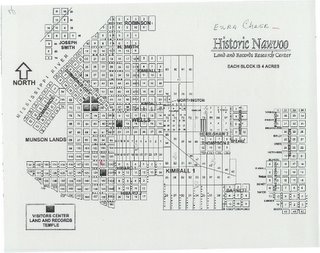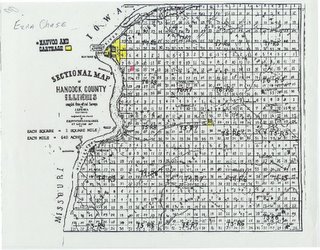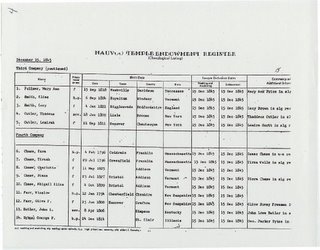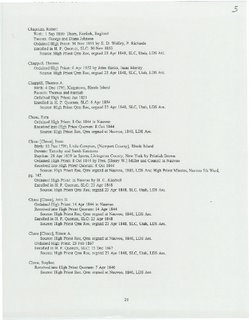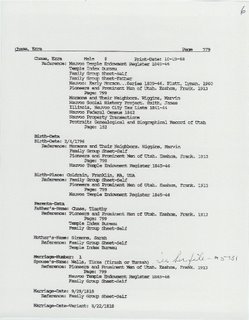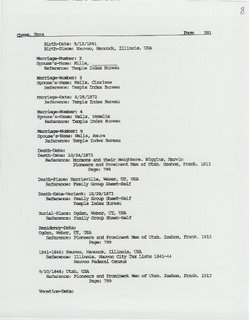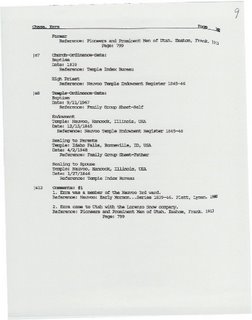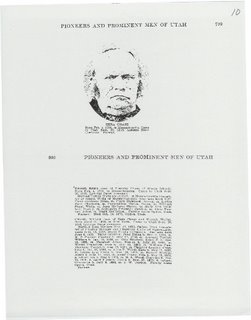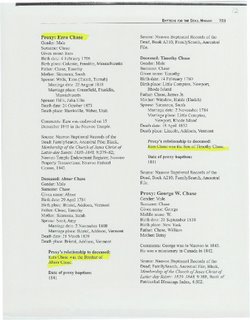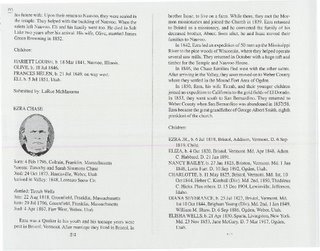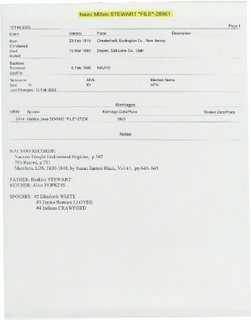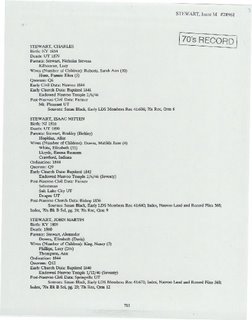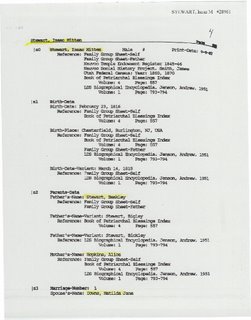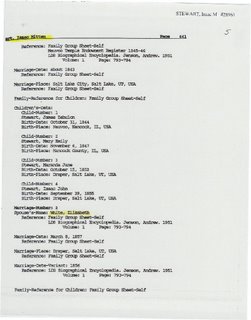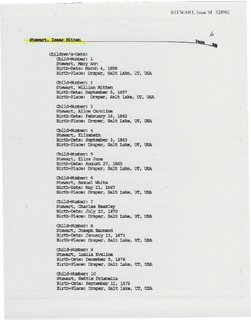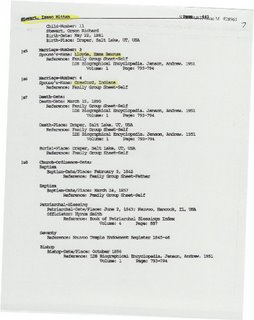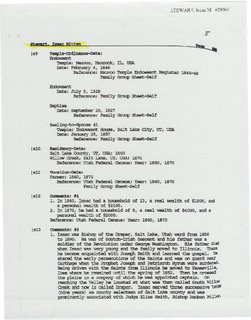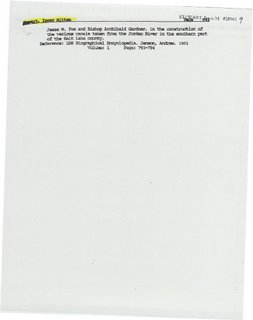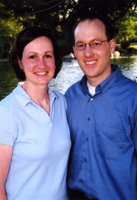Sunday, January 03, 2010
6 Elizabeth White
link to text
link to additional text
Mary Ann Syer & William White > Elizabeth White & Isaac Mitton Stewart > Elizabeth Stewart & William Wilson Fife> Isaac Davis Fife & Margaret Miller > Clyde Miller Fife
Sunday, July 30, 2006
11 John Waterman and Ann Sturtevant
http://www.geocities.com/watermanhubbard/watermanjohn.htm
Deacon John Waterman and Ann Sturtevant
(Deacon) JOHN2 WATERMAN (Robert 1), born at Marshfield, Mass, 19 Apr. 1642, died at Plympton, Mass. 14 Sept. 1718; married at Plymouth, Mass., 7 Dec. I665, ANNA STURTEVANT, born at Plymouth, Mass., 4 June 1647, died at Plympton, 9 Feb. 1719/20, daughter of Samuel and Ann Sturtevant.
Children of John and Ann (Sturtevant) Waterman, the first two were born in Plymouth, the rest in Marshfield, Mass.:*
i. SAMUEL, b. 16 Oct. 1666; d. 10 Mar. 1717/18
ii. ELIZABETH, b. 15 Jan. 1668/9; d. abt 1705
iii. ANNA H, 18 Oct. 1671; d. 11. Mar. 1735/6
iv. LYDIA, b. 9 May 1678; d. 23 July 1757
v. ROBERT, b. 9 Feb. 1681/2; d. 16 Jan. 1749/50
vi. JOHN, b. 23 Sept. 1685.; d. 8 June 1761
gravestones of Deacon John and Anna Sturtevant Waterman (1642-1718) are located in the Ye Olde Butial Gounds, Plympton, Mass.
As can be ascertained from the following records, John Waterman moved from Marshfield to Plymouth by the time of his marriage in 1665. Then, by the time of the birth of his children, he moved back to Marshfield, where the birth of his children are recorded from 1671 to 1685. Subsequently, he sold his homestead in Marshfield in 1687 and returned to the section of Plymouth which would be Plympton in 1695.
In 5 Oct. 1687, John and Anna Waterman were dismissed from the church in Plymouth church to join the new church in Plympton.
On 1 Aug. 1669, Samuel Sturtevant's will mentioned his son-in-law, John Waterman [The Mayflower Descendant, 18-188}. Anne Waterman was one of the witnesses to the will of Lt. John Tomson of Middleborough, Mass., 23 Apr. 1696 [ibid., 4-24.25].
Burials in Plympton, Mass.: Deacon John Waterman died Sept. 14, 1718 in 77th year. Anna Waterman, widow of Dea. John Waterman, died Feb. 9. 1719 in 71st year.
The will of John Waterman of Plympton, made 24 Mar. 1712, proved 19 Dec. 1718, named his sons Samuel, Robert, and John; wife Anna (sole executrix); daughters Anna Ransome, Lydia Shaw. and the children of daughter Elizabeth Ti1son deceased; granddaughter Mary Waterman, daughter of my son Samuel; son Robert was to have 'all that lot of land whereon I now dwell which did formerly belong unto Major William Bradford* .. Inventory taken 29 Oct. 1718. [Probate Rec. Plymouth County, 4-151, 152, 162.] John Waterman was in the list of Freemen, 29 May 1670; served on juries, 5 July 1671, 8 Oct. 1689, and 2 July 1690; he served 20 Oct. 1675 on a coroner's jury which brought a verdict on a drowning. [N. B. Shurtleff: Records of the Colony of New Plymouth, 5-182, 274; 7-167, 304, 310.]
The church in the eastern part of Plymouth, which became Plympton, has records going back to the start. "Whereas the Inhabitants of the eastem part.
In ye year 1695 obtained Lihcrty of being a destinct Society by themselves from the General Court." etc. The Clurch Covenant was signed by: Mr. Isaac Cushman Mrs. Rebecca Cushman Experience Beard Jonathan Shaw Persis Shaw Johannah Briant John Waterman Anna Waterman Mercy Phinney Joseph Dunham Abigail Briant Elizabeth Sampson John Rickard Mercy Sturtevant Elizabeth Emerson Samuel Sturtevant Elizabeth Cook Mercy Dunham Stephen Briant Jr.. Elizabeth King Joseph King Mary Rickard Samuel Waterman., Rebeccah Richard Joseph Phiney Samuel Ransome John Emerson Elizabeth Cannady James Bears Esther Donham Samuel Briant Sarah Briant Jonathan Briant Hannah Curtice
Jonathan Shaw and John Waterman were ordained Deacons, Sunday, 27 Nov. 1698. John Waterman of Plymouth. ship carpenter, conveyed 12 May 1668 to Joseph Rogers Sen of Duxborough. planter; deed not recorded until 16 Apr. 1726. (Land Rec. Plymouth County, 20-107.] John Waterman of Marshfield sold his dwelling barn and meadow in Marshfie1d to John Carver of Marshfield, 19 Dec. 1687. [Land Rec. Plymouth CoIony, 1-65.] John Waterman and Samuel Sturtevant, both of P1ymouth. exchanged land, 5 1uly 1699. John Waterman of Plympton , yoeman, conveyed 20 acres in Plympton, 31 Mar. 1705,.to ":My son Robert Waterman" of Plympton John Waterman Sen of Plympton sold 22 acres in Plympton. 2 Mar. 1708/9, to Mr. Josiah Holmes of Duxbury- On 3 July 1707 John Waterman Sen of Plymouth conveyed in Consideration of y Natural affection 1 bear unto my loving Son John Waterman jun of Plymouth". John Waterman of Plympton, yeoman, sold land, 7 Dec. 1713, to Isaac Lothrop. On 16 Dec. 1713, John Waterman of Plympton "for and in Consideration of the fatherly Love & affection which I Have & Bear to my Son Samuel Waterman of Plympton conveyed land to him. He conveyed for "Love and affection," to his son Robert of Plympton, yoeman* all that my homestead whereon I now dwell in Plympton afores wth did formerly helping unto Maj William Bradford Deceased, reserving life use. [Land Rec. Plymouth County, 6-203; 7-44; 8-4; 10-444, 445, 446; 13-131.]
13 Philippe De D Lannoy
http://en.wikipedia.org/wiki/Delano_family
Here is the excerpt from Wiki -
Delano family
From Wikipedia, the free encyclopedia
Jump to: navigation, search
The Delano family in America was founded by Philippe Delano (de Lannoy), a 19-year-old Separatist of Walloon descent who arrived at Plymouth, Massachusetts on November 9, 1621 on the ship Fortune.
Philippe was born December 7, 1602 in Leiden, the Netherlands, the son of Jan Lano (1570-1604) of Tourcoing and Marie le Mahieu of Lille, both in Walloon Flanders, then part of the Spanish Netherlands. Philippe's grandfather, Guillebert de Lannoy, was an early Calvinist who left the mainland for England probably in the early 1570's and then, in 1591, settled with his family in Leiden. The Mahieus had arrived in Leiden from England in 1590, the year before the de Lannoys. The family name of de Lannoy likely derives from the small town of Lannoy (originally Alnetum), east of Lille, present-day France. There is no known evidence to substantiate claims that Philippe descended from royalty.
As a teenager, Philippe Delano was a member of the Leiden Walloon Church (Waalse Kerk) and later entered the Separatist congregation established by the Pilgrims from Plymouth, England under the leadership of the English Separatist John Robinson. The decision to relocate the group to America came early in 1619, when Deacon John Carver and Robert Cushman, who had business experience, were sent to London to negotiate with the London Company. They carried with them articles of belief, written by Robinson and Brewster, as evidence of their loyalty and orthodoxy. The Leiden Separatists bought the ship Speedwell in Holland, and Philippe, with his uncle Francis Cooke and cousin John boarded the ship with the others at Delftshaven whence it sailed to Southampton, England to meet the Mayflower, which had been chartered by the English merchant investors. There they joined with other Separatists and the additional colonists hired by the investors. The two ships began the voyage, but the Speedwell leaked so badly that the expedition had to return to England, first to Dartmouth and then to Plymouth. Finally, Speedwell was sold and Mayflower set out alone from Plymouth, England. Ten Speedwell passengers (including Francis and John Cooke) joined the Mayflower. Philippe and the others remained behind in England until a replacement ship, the Fortune, finally sailed for Plymouth Colony in early July 1621, arriving at the Plymouth Colony on November 9.
Philippe Delano joined and resided with his uncle John Cooke, who had arrived the year before. In 1623, he received a land grant in Plymouth but sold this property in 1627 and moved to Duxborough where in 1634 he married Hester Dewsbury (1613-1657). There, Delano prospered and was part of the group of men who organized the construction of highways and bridges around the village.
Philippe Delano served in the Pequot War of 1637 as a volunteer. In 1652 he joined with 35 other colonists to purchase what was then called Dartmouth Township from Massasoit, the leader of the Wampanoag Indians. Philippe gave his portion of the acquisition, amounting to 800 acres (3.2 km²), to his son Jonathan Delano who later fought in King Philip's War. Following the death of his wife, he married a second time to Mary Pontus. Jonathan married Marcy Warren, granddaughter of Mayflower passenger Richard Warren.
Philippe died on August 22, 1681 in Bridgewater, Massachusetts. A great many of his offspring would become prominent mariners, whalers, and shipbuilders. The family's commercial success was such that they would become part of the Massachusetts aristocracy, sometimes referred to as one of the Boston Brahmins (the "First Families of Boston").
Over time, family members migrated to other states including Michigan, Maine, New York, Ohio, and Vermont and as far away as Chile where today descendants of Captain Paul Delano are numerous and prominent. From the New York clan, Sara Delano married James Roosevelt and their only child, Franklin Delano Roosevelt became President of the United States.
The Delano name is also found across America where several places have been named in honor of a family member:
Delano, California named for Columbus Delano
Delano, Minnesota named for Francis R. Delano
Delano, Pennsylvania & Delano Township, Pennsylvania named for Warren Delano II
Some notable members of the Delano family in America:
Barbara Delano, wildlife conservationist
Columbus Delano (1809-1896), statesman
Diane Delano, (born 1957), actress
Francis R. Delano, (1842-1892), banker, railroad executive
Jane Delano, (1862-1919) prominent nurse
Joseph C. Delano, (1796-1886), ships captain
Gerard Delano, (1890-1972), painter
Lee Delano, actor
Paul Delano, (1775-1842), Commander of the Chilean Department of the Navy
Suzanne Upjohn DeLano, (born 1922), pioneer aviatrix
Warren Delano II, (1809-1898), merchant of the clipper ship period
Franklin Delano Roosevelt, (1882-1945), President of the United States
Warren Lyford DeLano, (1972-), Open source software evangelist and author of PyMOL.
William Adams Delano (1874-1960), architect
William A. Delano (1924-2003), First General Counsel of the Peace Corps
12 Philip Sherman
I have included the text of this website below. Please enjoy.
http://sherman-roots.com/sherman/bio/07-sherm-philip.html
Philip Sherman, Honorable
Philip Sherman (7), 1610-1687Sarah Odding (7), 1610-1681
1610. Philip Sherman was born and baptized February 5th, 1610 in Dedham Essex County England, he was named after his mother Phillippa Sherman.
1633. Philip Sherman joined the great Puritan migration to the Massachusetts Bay Colony when he was in his early twenties. He settled near Boston in Roxbury in Suffolk County. He was a member of the Congregational Church. The established church in 1600 & 1700s, which was supported by township taxes, and the township buildings were used for both government and church functions. There were about 20,000 English who migrated to the New England Puritan colonies between 1630-1640. Philip became a Quaker later in Rhode Island.
1633. Records from the Church of Christ at Roxborough MA indicated: "Philip Sherman came into the land in 1633, a single man. The man was of melancholy temper. He lived honestly an comfortably among us several years.
1634. Philip Sherman married Sarah Odding in Roxbury MA in Suffolk County. Sarah was the daughter of George Odding and Margaet Lang (Odding) (Porter), Sarah Odding was the daughter of the of the wife of John Porter by a Former husband.
1634. Philip was made a freeman on May 14th. In Massachuset being a freeman meant common ownership in the town lands and the right to vote. Later it meant just the right to vote. A person had to apply, and have the approval of the governing body. In 1746 all freeman were required to take an oath against bribery and corruption.
1635. Philip Sherman returned to England for about a year, with the blessing of the church. To urge other of the Sherman relatives to come to America.
1637. The Anne Hutchinson Affair. Philip took the popular side with the Boston Puritan leaders Mr Wheelright and Mrs Anne Hutchinson, on church issues and procedures. Governor Winthrop took the opposite side, and after Anne Hutchinson defied the Governor she was put on trail, and was sentenced to banishment from the Church and the Colony of MA. Philip Sherman, after his father-in-law John Porter was so carried away with the opinions of familism and scims, he followed them and removed with them to the (Rhode) Island. He behaved himself sinfully in these matters... and was cast out by the Church.
1637. November 20th, followers of Anne Hutchinson, including Philip Sherman, were ordered by the court to give up their arms including guns, pistols, swords, powder, shot or match. In order to prevent armed opposition.
Anne Hutchinson was brought to trail for having broken the Fifth Commandment (Honor thy father and thy mother...) By bring reproach upon "the fathers of the commonwealth" On November 2, 1637 Anne Hutchinson was convicted and sentenced to banishment "as being a woman not fit for our society." Several of Mrs Hutchinson's followers, including Philip Sherman, saw fit under the circumstances, to follow her to the Providence of Rhode Island, where religious freedom existed.
xxxx. Philip had intended to settle in New Hampshire, but concluded the climate was too severe and the lands there were abandoned.
xxxx. An old saying about those who left Massachusetts colony was that, "if you were too good to stay you went to Connecticut, but if you were not good enough to stay you went to Rhode Island.
1638. One of the first settlers in RI was Roger Williams in 1636. He bought land from the Indians, and settled in Providence, then called Seekonk, Roger Williams was banished from MA Colony the previous year for similar reasons as Philip was. The group Philip was with was advised by Roger Williams to purchase the island of Aquetnet, also called Aquidneck, from the Indians. The island is in Narragansett Bay.
1638. March 7th Philip Sherman and others signed the "Bodie Politick," which was "the articles of incorporation" of the group who purchased the island. This was also known as "The Portsmouth Compact." On March 24th the purchase of the island from the Indians was completed. The town of Portsmouth, then called Pocasset, was established first and then Newport was established in 1639.
1638. March 12th, a summons was issued in MA for Philip Sherman's appearance in court. Although he had a license to depart and had already removed to RI, he was still formally banished from MA.
1638. May 13th, Philip Sherman attended the first Portsmouth town meeting.
1639. July 1st, a regular government was established for the colony of RI. Mr Wm Coddington was chosen as the first Governor and Philip Sherman as the first Secretary.
1640. Philip Sherman and four others were chosen to lay out lands.
1641. March 16th, Philip Sherman was made a freeman.
1644. The name of the island changed in 1644 to "The Isle of Rhodes," the island from which the State of Rhode Island derived its name.
1644-57. Philip Sherman was chosen "Towne Clerke" of Portsmouth. Records started in 1639 were kept by another person. Philip started keeping records on Dec 223, 1644. There is no record of anyone being chosen to the position of clerk until Philip was chosen on June 2, 1649. The early records, prepared by Philip Sherman, still remain in Portsmouth, and shows him to have been very neat and expert penman, as well as an educated man.
1648-52. Philip Sherman was general recorder for the Colony of RI.
1648-72. Philip Sherman was Surveyor of Cattle for Portsmouth, two times.
1650-51. Philip Sherman was town recorder of Portsmouth.
1650-73. Philip Sherman was member of the Portsmouth "Towne Council" seven times.
1651-84. Philip Sherman was Tax Assessor thirteen times for the town of Portsmouth.
1656. Philip Sherman was Magistrate for the town of Portsmouth.
1656-67. Philip Sherman was Deputy to General Court (Assembly) of the Colony of RI three times.
1556-68. Philip Sherman was Town Auditor of Portsmouth three times.
1660. Philip Sherman was grand Juror at the RI Colony's General Court of Trails.
1675-6. King Philips War. King Philip was chief of the Wampanoag Indians, and was the son of Marsosoit from whom the Island of Rhode was purchased from. He rebelled against the English. He raided and burned settlements and towns, and many colonist were slain. The first attacks were about Narragassett Bay, then they spread throughout the New England Colonies. The Indians were subdued. The end of the war resulted in virtual end of tribal Indian Life in southern New England, and the end of the fur trade.
1676. April 14th Philip Sherman was one of the sixteen men, the most judicious inhabitants whose advice and concurrences was requested, by the Colony of RI and the Providence Plantations, to be a member of the Council for King Philip's War.
1679. April 23rd Philip Sherman became tax assessor for Portsmouth.
1681. Philip prepared his will.
1681. Sarah Odding (Sherman) died at Portsmouth RI.
1683. April 4th Philip Sherman was chosen to lay out a highway.
1684-5. Philip Sherman was a member of Committee of Adjudication.
1686. March, Philip Sherman died at Portsmouth RI, in Newport County. He was immensely wealthy as a planter, as a live stock owner, and as owner of hundreds of acres.
1686/7. March 22nd Philip Sherman's will proved: No records of an inventory in his estate records.
xxxx. On the geography of RI, Philip is remembered only in he fact that a pond in the Narragansett county is named Sherman Pond.
xxxx. Philip Sherman, Secy. of RI Colony, used arms: "On a Shield (Silver) a Lion rampart (legs elevated) sable (black lion), between three oak leaves (forest green) vertical. Motto under the shield was Virtute Vincere (conquer death by bravery). This shield was granted to the Shermans of Yaxley in County Suffolk in England by King Henry VII. Of many related Shermans of this emigrant generation who must have used their arms, Philip is the only one noted. S V Talcott's Genealogical Notes of NY & New England Families, p680)
Additionally, you can go to a favorite website for googlers.
http://en.wikipedia.org/wiki/Philip_Sherman
Sunday, February 19, 2006
Thursday, February 16, 2006
6 Isaac Mitton Stewart

Stewart, Isaac Mitton
Stewart, Isaac Mitton, Bishop of Draper, Salt Lake county, Utah, from 1856 to 1890, was the son of Bickley Stewart and Alice Hopkins and was born at Burlington, New Jersey, March 14, 1815. He was of Scotch-Irish descent and his father was a soldier of the Revolution under George Washington. His father died when Isaac was but a lad, and the family moved to Illinois, where Isaac (then a young man) became acquainted with Joseph Smith's mission and embraced the gospel. In 1843 he married Matilda Jane Downs. He shared the early persecutions of the Saints, and was on guard near Carthage when the Prophet Joseph and Patriarch Hyrum were murdered. Being driven with the Saints from Illinois, he moved to Kanesville, Iowa, where he remained until the spring of 1852, when he crossed the plains in a company of which he [p.794] was appointed captain. On reaching the Valley he located at what was then called South Willow Creek, now Draper, Salt Lake county. In October, 1856, he was set apart to act as Bishop of Draper Ward, in which capacity he served faithfully until his death, which occurred at Draper March 15, 1890. In 1856 he married Elizabeth White and Emma Lloyd, with whom he had a large family, being the father of twenty children and having eighty grandchildren. Thirteen of his children are now living. They are: James Z. Stewart of Logan; Isaac J. Stewart of Richfield; Joshua B. Stewart, William M. Stewart, Samuel W. Stewart, Charles B. Stewart, Barnard J. Stewart, all of Salt Lake City; Mary Ann Ballantyne, Logan; Alice C. Stringfellow, Draper; Elizabeth Fife, Ogden; Eliza J. Fife, Salt Lake City; Luella E. Lindsay, Montpelier, Idaho, and Nettie P. Stewart, Salt Lake City. Bishop Stewart served three successive terms (nine years) as county selectman of Salt Lake county, and was prominently associated with Judge Elias Smith, Bishop Reuben Miller, Jesse W. Fox and Bishop Archibald Gardner, in the construction of the various canals taken from the Jordan river in the southern part of Salt Lake county. He was strong and energetic in mind and body and had a progressive disposition, always taking an active interest in education. It was largely through his influence that Dr. John R. Park was employed and retained in educational work in Utah. Bishop Stewart was a typical example of a sturdy pioneer, honest and upright in every particular. His life and interests were centered in his religious faith.
Source:
(Jenson, Andrew. Latter-day Saint Biographical Encyclopedia: A Compilation of Biographical Sketches of Prominent Men and Women in the Church of Jesus Christ of Latter-day Saints. 4 vols. A. Jenson History Company and Deseret News, 1901-36.)
Additional Information:
Stewart, Isaac Mitton
Birth Date: 14 Mar. 1815
Death Date: 15 Mar. 1890
Gender: Male
Age: 37
Company: Isaac M. Stewart Company (1852)
Pioneer Information:
Captain of company; with 8 people
Sources:
1850 Iowa Census, Pottawattamie Co., p. 129 Source Locations
Ancestral File Source Locations
FIX Deseret News, 18 Sep. 1852, p. 2 FIX Source Locations
Journal History, Supp. to 1852, p. 55 Source Locations
Additional Information:
Isaac M. Stewart Company (1852)
Departure: 19 June 1852
Arrival in Salt Lake Valley: 28 August - 22 September 1852
Company Information:
About 245 individuals and 53 wagons were in the company when it began its journey from the outfitting post at Kanesville, Iowa (present day Council Bluffs).
Isaac M. Stewart Company (1852)
Sources:
Harper, John, Autobiography [ca. 1861]. Source Locations
Hatch, Josephus, Diary. Source Locations
Robertson, Alexander, Autobiography and genealogy of AlexanderRobertson . . . 1916. Source Locations
Sunday, February 05, 2006
6 William Nicol Fife
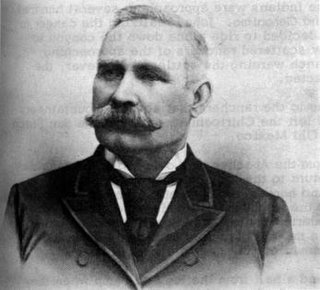 William Nicol Fife is 6th generation from me. His life history is recorded below, as found in Orson F. Whitney, History of Utah, Vol. 4, p. 162 - 164.
William Nicol Fife is 6th generation from me. His life history is recorded below, as found in Orson F. Whitney, History of Utah, Vol. 4, p. 162 - 164. Orson F. Whitney, History of Utah, Vol. 4, p. 162
A wide-awake, useful career, thrilling and even tragic in some of its phases, is that of William N. Fife, a prominent citizen of Weber county, who has also been a colonizer in Arizona. A native of Scotland, he was born at Kincardine, Perthshire, on the 16th of October, 1831. His parents were John and Mary M. Nicol Fife. The father was reared on a farm, but later in life followed surveying as a profession. William received a good education, and at the age of fifteen was apprenticed to a carpenter and builder for a period of five years.
Orson F. Whitney, History of Utah, Vol. 4, p. 162
At the end of his apprenticeship he found employment in the city of Glasgow, with the firm of J. Nairn and Sons, builders, and remained with them for nine months, after which he fitted out for Melbourne, Australia, to go into the building business with his uncle, Thomas Fife, who for eight years had been a resident of that land.
Orson F. Whitney, History of Utah, Vol. 4, p.162
He sailed from Glasgow August 2, 1852, and next day reached Liverpool, intending to travel through England and re-sail in the winter from London. At Manchester he entered into a contract with a building firm for one month, and took lodgings in a house which proved to be the Mormon conference house. There he met Alexander F. McDonald, Cyrus H. Wheelock and other missionaries from Utah, and was converted to their faith. He was baptized by an Elder named Lamb, and confirmed by one Elder France, on the first day of October. The course of his life was now completely changed; he thought no more of going to Australia, but made up his mind to emigrate to Utah.
Orson F. Whitney, History of Utah, Vol. 4, p.162
On the 7th of April, 1853, he sailed with a company of Latter-day Saints for New Orleans, where he arrived on the 2nd of June. There he met John Brown, the Utah Pioneer, who took charge of this the last company that crossed the plains to Salt Lake valley that season. Mr. Fife was the carpenter and a captain often among these emigrants, whom he helped to fit out at Keokuk, Iowa. They started from that point on the 27th of June—fifty-five wagons, with two yoke of oxen to each wagon—and reached Salt Lake City on the 20th of October. Seven lives were lost between Liverpool and the end of the journey.
Orson F. Whitney, History of Utah, Vol. 4, p. 162
Mr. Fife's first employer in Utah was President Heber C. Kimball, with whom he remained, in charge of his building business, for eighteen months, and at whose house he married, July 9, 1854, his first wife, Miss Diana Davis, daughter of Daniel and Sarah Davis; President Kimball performing the ceremony. Their first child, Sarah Jane Fife, was born July 10, 1855, at her father's home in the Sixteenth Ward.
Orson F. Whitney, History of Utah, Vol. 4, p.162
In the fall of 1856, the Fife family moved to Ogden, the head of the house having entered into a contract to complete the Tabernacle in that city. His partner was Walter Thompson. The other parties to the contract were Chauncey W. West and Albern Alien. His first son, William Wilson Fife, was born at Ogden, August 16, 1857. This was the year of the Echo Canyon war, in which Mr. Fife, who had seen volunteer service in the Indian troubles of 1853, and had risen from corporal to second lieutenant in the militia, figured as first lieutenant and subsequently as quartermaster, with the rank of captain. He went with the Weber and Box Elder militia to head off Colonel Alexander, who was endeavoring to enter Salt Lake valleys by way of Soda Springs; and afterwards served in Echo Canyon. Returning from the "move," Mr. Fife next entered into building contracts at the military post rounded by the government troops in Cedar valley.
Orson F. Whitney, History of Utah, Vol. 4, p.162
"This," says he, "brought a great amount of money into the Territory, In company with my old friend, Walter Thompson, I started for Camp Floyd, arriving there September 15, 1858. We entered into a contract to put up government buildings at the post. We were treated with great courtesy by General Johnston and the other officers, and profited handsomely by our contract, hi 1859 we built a tannery for West and Hammond at Ogden; also stables for Wells Fargo and Company, who were running a stage line from Salt Lake City to Montana, hi 1860 I helped to finish the Seventies' Hall in Salt Lake; and later assisted to build the Ogden House for C. W. West, a store for William Jennings at Salt Lake City, and many other buildings of note.
Orson F. Whitney, History of Utah, Vol. 4, p. 163
[p. 163] hi April, 1862, Mr. Fife was appointed city marshal of Ogden, succeeding James McGay, and was elected to the same office February 1, 1863, and re-elected for many succeeding terms. Subsequently he was coroner for Weber county and pound-keeper of his district, hi April, 1863, he was a member of the High Council of Weber Stake, in the fall of 1864, he presided over the local dramatic association.
Orson F. Whitney, History of Utah, Vol. 4, p. 163
All along he continued to be active and prominent in military matters. As regimental Adjutant, he organized the first company of militia in Ogden valley, July 24, 1862. hi January following he witnessed the battle of Bear River, where Colonel Connor annihilated the hostile Shoshones of Southern Idaho. Marshal Fife assisted in getting teams to convey the wounded soldiers to Ogden. On July 1, 1866, he became a Colonel of Infantry hi the Weber Military district.
Orson F. Whitney, History of Utah, Vol. 4, p. 163
In 1868, when contracts were let to build the grade of the transcontinental railroad across Utah, he, with Joseph Parry, to whom he was second counselor in the third ecclesiastical district of Ogden, took a contract to build several miles of the Central Pacific road between Promontory and Ogden. Between September 28 and the following December they completed the work, paying off their men and doing well for themselves. At the jubilation over the advent of the iron horse into Ogden Mr. Fife was marshal of the day. About this time he acted as a school trustee, and at all times did everything in his power for the improvement and advancement of the town. Concerning some of the events following the advent of the railroad he says:
Orson F. Whitney, History of Utah, Vol. 4, p.163
"In May, 1870, the smallpox was brought into Ogden, supposedly by an Indian squaw. The first person taken down with it, a Mrs. Eggleston, died, and later some of Walter Thompson's family were afflicted with it, and one died. John Murphy and his wife also fell sick, and Mayor Farr thought it best to move them up on Brick Creek. Accordingly I erected a lumber room and moved them to it, furnishing them with food and other necessaries. The city was placed under quarantine, and I was instructed to follow up the disease with disinfectants and place a yellow flag in front of every afflicted house. I attended to this duty personally. By July forty cases were moved from their city homes to Farr's Grove on the banks of the Ogden river, the Mayor assisting me in this work. Very soon he was taken down with the disease, though in a mild form, and was also moved to the grove, where at the end of July I had eighty-nine cases. I got good kind nurses for the sick, and by strict regulations in the camp and the city the contagion was prevented from spreading any further. About half the people in camp I furnished with supplies from Z. C. M. I, at the expense of the city. A great portion of the time I was on the move day and night, and though handling most of the sick people in taking them to the grove, I was not attacked by the disease. Only seven of the eighty-nine cases proved fatal, and by the end of October all survivors were back in their homes. In 1876 the smallpox again took Ogden by storm, and as city marshal I worked day and night to destroy the disease. It was practically a repetition of my former experience, though most of the sick were quarantined in their own homes. Many lives were saved, and by the 28th of December the quarantine was raised. The scourge lasted over three months. The city paid me well for my services, and many leading men of the town presented me with tokens of respect.
Orson F. Whitney, History of Utah, Vol. 4, p. 163
"Many strangers from East and West had made their homes in Ogden; the hotels were crowded, and the railroads brought many bad characters. I had plenty to do, making many arrests, newly equipping the police force, furnishing and refitting the city hall and adding more cells for prisoners. Among the cases brought to justice was a man named Lee, living with some ticket brokers at the Ogden depot. He had committed a dastardly outrage on a Mrs. Parley, a lady from the East. I followed him to Tacoma, Nevada, and arrested him in bed in the presence of four of his friends; a local officer accompanying me. I hand-cuffed my man and brought him back to Utah, where he was tried, found guilty and sentenced to the penitentiary for four years."
Orson F. Whitney, History of Utah, Vol. 4, p. 163
In the fall of 1873 Mr. Fife went on a mission to his native land, and at Glasgow hunted up and visited his relatives, whom he had not seen for twenty-three years. None of them knew him. He found his father and his grandmother, the latter in her ninety-third year. He describes it as "a great meeting." He fulfilled a successful mission, baptizing many, and having charge of the Mormon emigration from Glasgow to Liverpool, by appointment of President Joseph F. Smith. He returned home in November, 1874. From 1877 to 1880 he superintended the erection of various buildings, the last being the Central schoolhouse at Ogden, considered at the time the finest school building in the Territory.
Orson F. Whitney, History of Utah, Vol. 4, p. 163
He next turned his attention to the South, starting early in November, 1880, with a view to exploring in Arizona and Mexico. He was accompanied by his second wife, a [p. 164] widow of Captain James Brown; and by her son Orson, her daughter Cynthia and his first wife's sons, John D. and Walter F. Fife. By way of Kane county they crossed the Buckskin mountains, the Big and Little Colorado rivers, and arrived on the Gila February 1, 1881. After exploring a week in that vicinity they proceeded on through the San Simon valley, struck the S. P. R. R. (just completed) and thence by way of the Apache Pass reached the great Sulphur Spring valley, where Mr. Fife left his family while he explored Sonora in Mexico; an account of which he wrote to President John Taylor. In the Sulphur Spring valley, at a place called Oak Grove, he located a fine ranch, and there, on the closing day of 1881, was joined by his first wife, Diana, his eldest son William W. and his daughter Agnes.
The country in which they settled, which was grassy, wooded and fertile, was claimed by the Chiricahua Apaches, who because of their blood-thirstiness had been placed by the government on the San Carlos reservation. In the spring of 1882 these Indians broke away from the reservation, got into the mountains and went into Mexico, some of them also making a raid on the Arizona ranches. "My teams," says Mr. Fife, "were at the time in Pinery Canyon, nine miles above the ranch, at Lobley's logging camp; my son John D. being engaged in hauling logs to the silver mines at Tombstone. The Indians surprised them, killing Lobley and his partner, Fenroy. My son made for the hills and defended himself, lighting them alone, fifteen in number. He received two wounds; they tried to burn him out, but he made his escape; the animals were run off by the Indians. He was taken to Rigg's Ranch, and afterwards to my home. We followed the Indians, who went through the mountains to Sonora. I now built an adobe house to supplement my frame house, and provided it with port-holes on three sides as a protection against Indians. Soon after this I was visited by Brothers Erastus Snow, Moses Thatcher and Christopher Layton, whom I assisted in exploring for the benefit of our people." Mr. Fife also aided General Crook, who had been sent by the government to put the Indians back upon the reservation. He speaks of him as a brave, wise and kind officer. The Indians yielded to his persuasions, and he did the country a great service.
Orson F. Whitney, History of Utah, Vol. 4, p.164
And now came an episode that cast a deep shadow over a career for the most part happy and prosperous. On the 10th of September, 1883, Mrs. Diana Fife was murdered at Oak Grove ranch by a Mexican desperado, whose purpose seems to have been plunder. The day before the deed was done Mr. Fife had gone to the nearest Wells Fargo Company's office, forty-five miles away, to express money to some of his folks who had been to the St. George Temple and were expected home after visiting friends in Ogden. His sons John and Walter were down on the bottom lands, cutting hay, and the only ones at the ranch were his wife Diana, her daughter Agnes and a hired man, a worthy, kind-hearted Mexican, who chopped wood and did other work about the place. Choosing his time, the desperado, who had evidently planned the murder of all three, presented himself at the door, and diverting Mrs. Fife's attention by saying "Look!"—at the same time pointing to a window—he drew a pistol and shot her. The ball passed through the upper part of her hip, and she fell mortally wounded. He then aimed at the daughter, but the gun would not revolve. At this moment the hired man sprang upon and disarmed the murderer, and as he fled fired several shots after him, none of which took effect. He made for the hills and escaped. Mrs. Fife died in a short time. Her husband arrived home at daybreak next morning, to receive, along with the terrible tidings, the sympathy of many kind friends who had gathered to offer aid and condolence. With characteristic promptness he had the news spread in all directions, and every available man and boy was soon in the saddle, scouring the country in quest of the assassin. By ten o'clock that forenoon he was run down, captured and brought back, within half a mile of the scene of his crime, where he was examined, but would make no confession. A hundred men demanded his immediate death, and he was forthwith "strung up;" a horseman at one end of the rope being ordered to "take him off at full gallop." He hung for two days upon a tall oak tree, awaiting the arrival of the County officers.
Orson F. Whitney, History of Utah, Vol. 4, p. 164
Another Indian outbreak is described by Mr. Fife, the result, in his opinion, of the ill-advised appointment by President Arthur, in February, 1885, of an incompetent Indian agent. The savages killed men and destroyed property wherever they could. General Crook again took the field, and under orders from President Cleveland, captured most of the Indians and shipped them from Bowie Station to Florida. General Miles finished the work, though he was not as successful as General Crook had been, and finally Geronimo and the rest of the savages were taken out of the country. The troops were stationed at and near the Fife ranch during much of the trouble.
Orson F. Whitney, History of Utah, Vol. 4, p. 164
In 1887 Mr. Fife assisted Apostle Erastus Snow and others in exploring parts of Mexico, and subsequently sent one of his families to reside there. His third wife, [p. 165] Cynthia, and her family took up their abode at Oak Grove ranch. He is at present among his children in Ogden. One of his sons—John D. Fife—is in business at Salt Lake City.
There is additional information on William Nicol Fife at this website:
http://www.orsonprattbrown.com/Fife/WmNicolFife1831-1915.html
link to information about tabernacle with pictures






